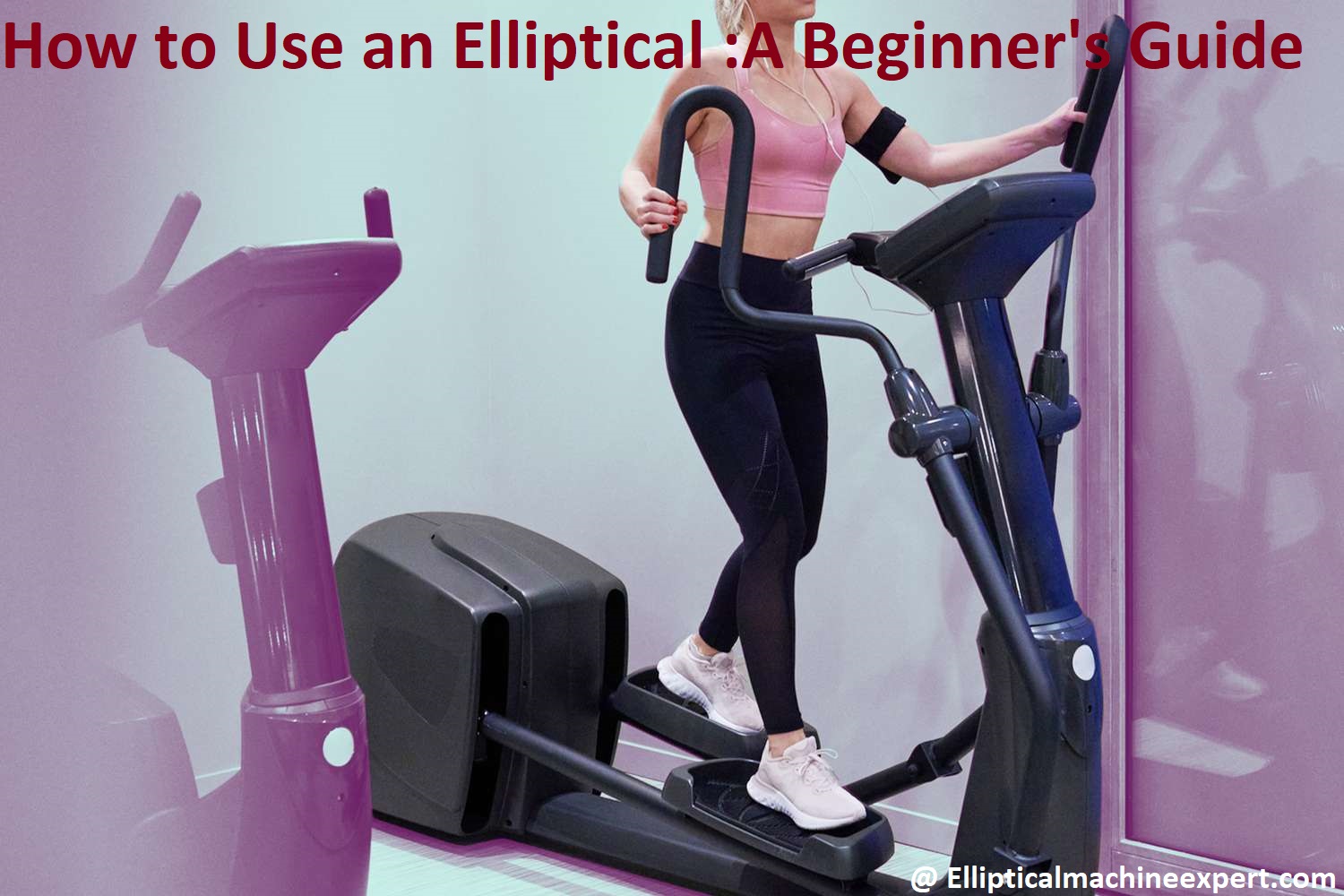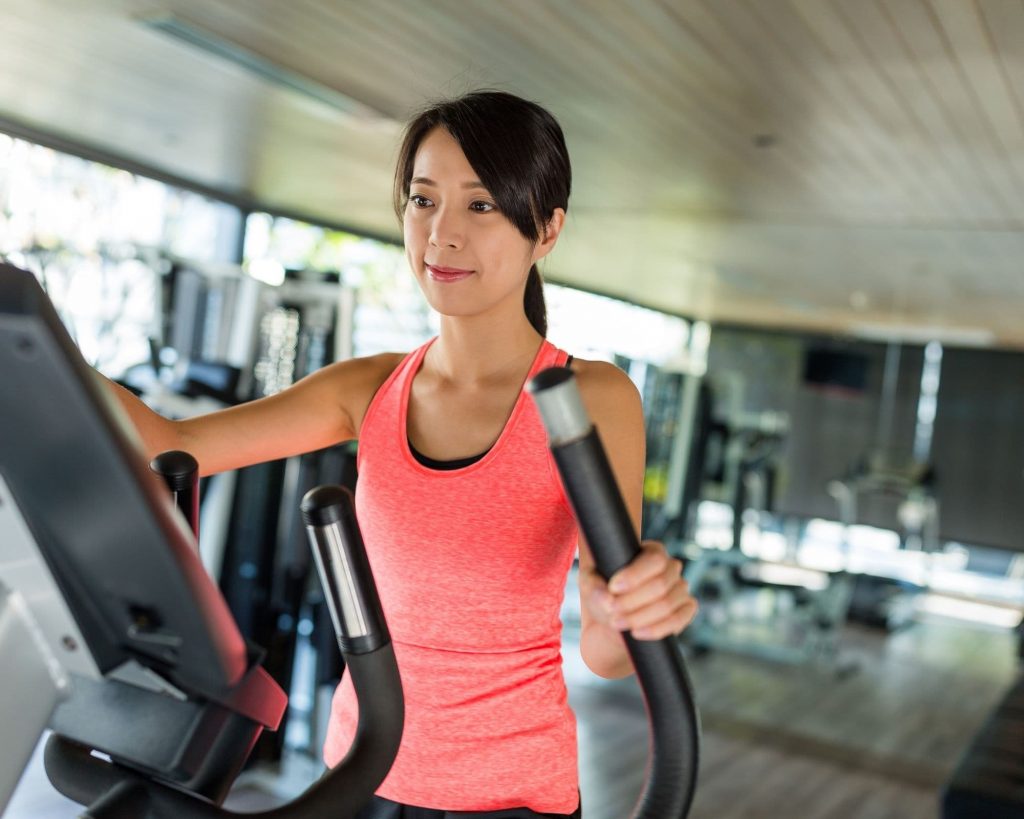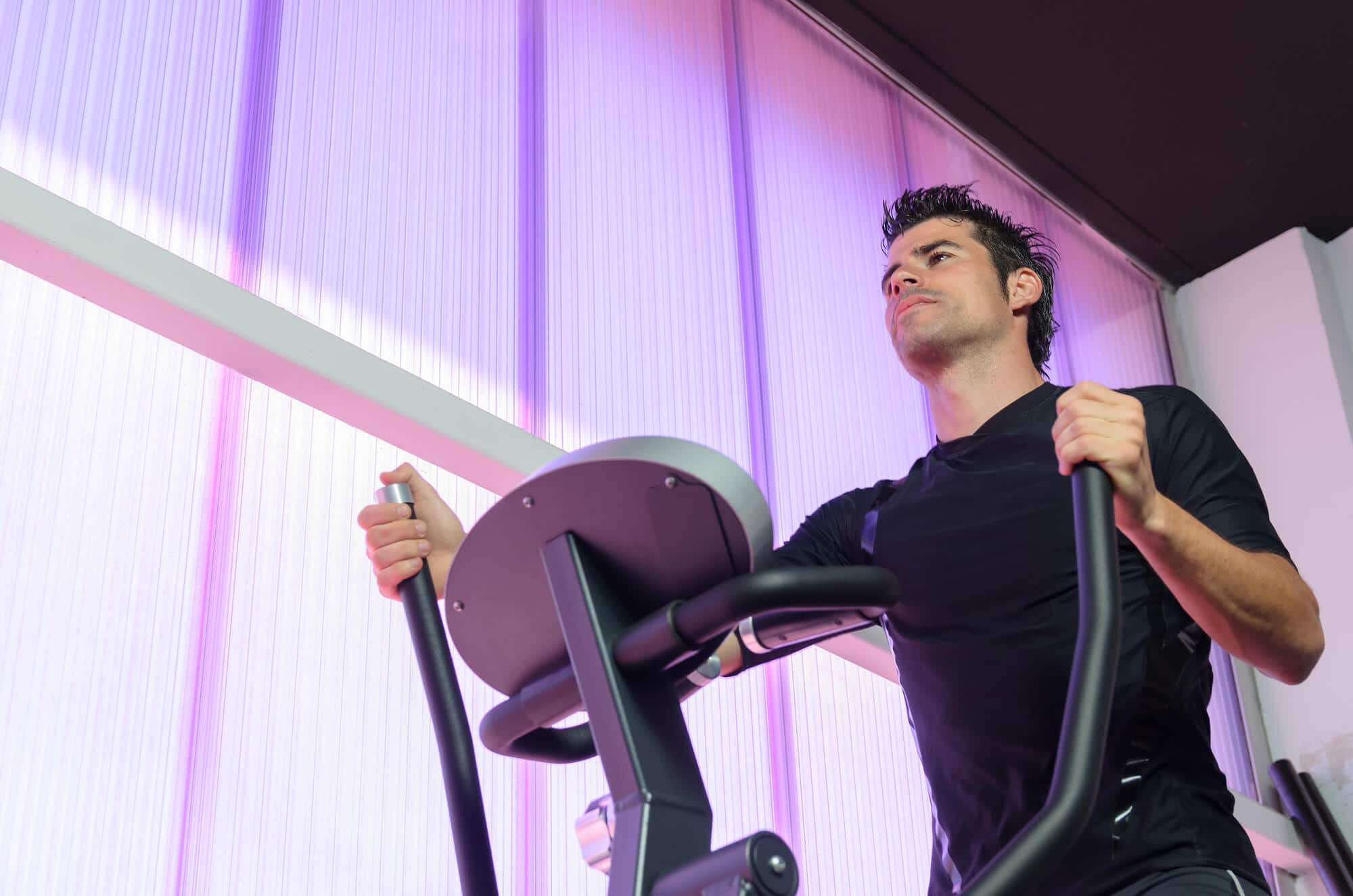Are you looking to get healthy and fit, but don’t know how to use an elliptical machine? You’re in luck!
This guide will provide you with the essential information to get started on your fitness journey. Learn the proper form and technique plus helpful tips to maximize your results!

Welcome to the world of ellipticals! This beginner’s guide is designed to show you the basics, from what an elliptical is, to how it works, and how to use it safely. Whether you’re a low-key exerciser or are looking for more of a challenge, there’s something here for every fitness enthusiast. Once you’ve read this guide and are comfortable with the basics, you can use the detailed steps below to practice your steel wheeling and start optimizing your routine for maximum calorie burn and long-term health benefits.
Getting Started
Now that you have an understanding of the basics of using your elliptical machine, it’s time to get started! Before you begin, make sure that your elliptical has been properly set up and all of the safety features are enabled.
The best way for a beginner to use an elliptical machine is to start with a lower resistance level and a comfortable pedaling pace. Take a few minutes at the beginning to warm-up your muscles by raising and lowering your arms in motion with the pedals. This will help you build a rhythm that will transfer easily from one leg to the other. It will also decrease stress on your joints, as well as help reduce any potential injury risk.
Once you feel comfortable with starting the motion, choose a program type on the console or increase the resistance until you find an intensity level that challenges your current fitness level without overworking your body. To maximize effectiveness, vary up programs and adjust resistance levels every five minutes or so while keeping track of time in each interval training section or increase intensity gradually throughout training session depending on program chosen on console. Make sure to maintain good posture throughout movement and keep scanning between legs, joints and muscles for any sign of trouble such as pain, fatigue or general discomfort.
Choosing the right machine
Choosing the right elliptical machine is an important part of getting the most out of your workout. The first step is to decide on the type of machine you want– recumbent, standing (Upright), or a combination of both. When selecting a machine, consider size and space requirements, as well as budget and personal preferences.
Take into account your fitness level and target goals when choosing an elliptical model; you’ll want to select one that enables a full range of motions to ensure a complete workout. Keep in mind that some machines are more customizable than others; if you’re looking for something that can be modified to your needs, choose one with adjustable difficulty settings, stride lengths, and resistance levels. You’ll also want to look at features such as paddles or handgrips that provide different kinds of exercise varieties.
Finally, make sure the elliptical you choose comes with all the necessary parts such as power cord, display console or monitor, pedals or handles and warranties. Quality matters too; take into consideration reviews from buyers who have had experience using the particular model in question. A good way to understand what features may fit your needs is researching reputable brands like Nautilus and NordicTrack who specialize in wellness equipment for home use. Check out their website for more information on how their machines might meet your exercise goals.
Proper attire and footwear
It is important to wear the proper attire and footwear so as to get the most from your workout, and to do so safely. Shoes that are designed for running or cross-training are ideal when using an elliptical machine. These types of shoes reduce strain on muscles, joints and ligaments and encourage a more effective workout session.
Additionally, you should opt for clothing that is comfortable and allows for full range of motion without being restrictive. Light and breathable layers are best as you may become warm or even too hot during your workout. It’s also a good idea to bring a towel along to wipe away sweat as needed so you can maintain your focus on each repetitious step.
III. Setting Up the Elliptical
Before using your elliptical machine, take a few minutes to make sure it is properly set up. This is an important part of ensuring your safety and optimal workout experience.
The first step is to read the user manual for your particular machine. This will provide detailed instructions and helpful tips for initial setup and ongoing maintenance. You should read the entire manual from start to finish before getting started, as it will offer the best advice for how to operate the elliptical safely and efficiently.

Next, familiarize yourself with all of the buttons, dials and settings on your elliptical. Determine which control each button or dial has over the workout experience such as resistance levels or intensity settings. Also be sure to check that all components are working correctly before starting any routine as a broken component may pose a safety hazard to yourself or others in addition to compromising your overall workout effectiveness.
Adjust the length of stride according to your body size; this will ensure proper form during exercises and avoid unnecessary strain on joints. Make sure that all knobs are tight enough so they don’t move during use; an improperly secured knob can cause irritation or even injury if it comes loose during use. Finally, find a comfortable starting level; this may be different depending on your goals — some users prefer low-intensity warmup period while others would rather jump right into higher levels of intensity directly.
Adjusting the stride length and resistance level
Adjusting the stride length and resistance level is an important part of using an elliptical machine. It allows you to customize the workout to your individual needs. Most ellipticals have a pre-set program which will automatically adjust the resistance and stride length, but if you want to adjust it manually, here’s how:
Resistance Level: The resistance level sets the intensity of your workout. It is usually changed by adjusting a knob on the main console or on the handlebars. Common adjustments range from 1-20, with higher numbers indicating a harder workout. Adjust it until you reach a level that’s comfortable yet challenging for you.
Stride Length: The stride length sets how long your strides are when using the machine. To adjust it, look for a button or lever usually located around waist height on one side of the console or handles. You can make minor adjustments with this control, usually up to 8-12 inches depending on your particular machine model. If possible, try out different stride lengths to find which feels most comfortable with your height and build.
Familiarizing oneself with the console and its features
Familiarizing oneself with the console and its features is an essential part of learning how to use an elliptical. Before beginning to exercise, it’s important to review the information contained in the owner’s manual and understand various safety instructions. After you have familiarized yourself with these instructions, you can safely begin your elliptical exercise routine.
The elliptical console will usually have an LCD display or a touchscreen that shows your progress as you exercise. Different models may contain different features, but almost all of them will present similar data such as time spent exercising, distance traveled, current speed and RPM (Revolutions per Minute). The console will also typically offer several pre-set programs tailored towards specific fitness goals like losing weight or increasing endurance. Many also feature a sound system and auxiliary port for personal devices such as smartphones or tablets. Extra features are often included on higher-end models such as personalized programs based on heart rate sensors and built-in Wi-Fi connectivity for tracking your performance over time.
Once you are comfortable with the features of the machine, it’s important to ensure that its adjustable components fit your body properly for maximum effectiveness. Adjusting the stride length, height of the handlebars, resistance level and other settings may require a few extra moments at first but will ultimately make exercising much more comfortable and enjoyable!
Using the Elliptical
Using an elliptical can be a great way to get a low-impact, full body cardio workout. To make the most of your equipment, it’s important to understand how your machine works and how to use it correctly. Here is a complete guide for novice users of ellipticals.
Before You Begin: Before you start using your elliptical, it’s important to adjust its settings correctly for the best possible experience. The handle grips should be adjusted so your arms are at a comfortable level and then make sure the pedals are securely in place and at an appropriate height. Also, check that all safety features are engaged before beginning your workout.
Positioning Yourself: Once you have adjusted your machine’s setting as needed, it’s time to mount the equipment in proper form. When standing on the pedals begin with both feet evenly placed on them then grab onto the handle bars with both hands so that you feel balanced and secure during your training session. Make sure that you stand tall with your legs straight (not bent) and remember always keep good posture—stomach facing forward—as this will help ensure that you are using proper form while training with an elliptical machine
Getting Moving: Now comes time to actually exercise! Begin by pushing down on one of the pedals starting from either foot first with moderate pressure keeping balance securely as move one foot after another pushing each pedal in sequence . Remember to also push forward and pull back on handles as you used both legs for optimum results—this simultaneous leg/arm coordination will help engage more of muscles when working out leading greater results achieved during exercise session in terms of calories burnt as well as muscle tone created
Proper posture and alignment
Proper posture and alignment when using the elliptical is key to both having an effective workout and avoiding injury. It’s important to keep your head up, your back straight, and your arms slightly bent. Your feet should be firmly planted on the pedals, with the majority of your weight placed on the balls of your feet. Make sure that you don’t lean forward or rest on the handles — this can interfere with proper movement.
It’s also important to remember not to arch or hunch your shoulders — keep them down and relaxed throughout the exercise. Finally, try to find a comfortable pace that allows you to stay in control without overexerting yourself — it will make for a more enjoyable workout!
Breathing techniques
Once you have become comfortable on your elliptical machine, you need to learn proper breathing techniques. It’s important to time your breaths along with your strides so that oxygen reaches your muscles effectively and efficiently.
To ensure that you are getting the most out of each session on the elliptical, try taking deep breaths through the nose and releasing them slowly through your mouth while moving. This will keep you more alert and help prevent fatigue during longer workouts.
Keeping a steady breath will also help improve endurance, as well as provide both discomfort relief and a sense of control over how long you can last. With every stride, attempt to inhale for two strides and exhale for two strands in order to get maximum benefit from this exercise!
Maintenance and Care
Once you have mastered the fundamentals behind how to use an elliptical and understand the importance of proper form and intensity, taking care of your machine is the key to maintain a safe and effective workout. Making sure your machine is well-maintained will not only extend its life span, but it will also ensure that your exercise experience is consistent each time you use it.
Regular maintenance should include inspection for loose bolts, nuts and screws; checking for frayed wires; lubricating plastic and metal parts; testing safety switches; and wiping off excess sweat from handles and sensors. Additionally, making sure your elliptical’s belt tension is adjusted properly will reduce wear on both the drive motor and walking belt. Finally, checking the manufacturer specifications of your particular machine will help you understand what other maintenance may be necessary. Maintenance intervals vary depending on usage so teaching yourself these basics should put you on track to staying injury-free while maintaining a healthy lifestyle!
Regular cleaning and inspection
Maintaining a clean and well-oiled elliptical machine is important for ensuring safe and effective workouts. Regularly inspecting and cleaning your machine helps keep your exercise equipment in peak form and prevents frustration from small issues that can quickly turn into major problems.
Here are some tips for regular cleaning and inspection that should be done regularly on your elliptical machine:
Clean the frame: Wipe the frame down with a damp cloth to remove any built up dirt or sweat, then dry it off. This will keep it from getting rusty over time.

Inspect all components: Check to make sure all parts of your machine are securely attached, including the pedal arms, handlebars, foot pedals, wheels and covers. Check the drive belt for any signs of wear or fraying. Visualize all electrical connections to confirm they are plugging in correctly and protected by an insulator cap.
Inspect the rollers: Rollers provide an essential component of friction free movement between your pedals and flywheel on an elliptical machine; inspect the rollers often to ensure they are in good condition. Look out for signs of wear such as chipping, cracking or distortion; if these indications appear replace them immediately to prevent further damage with use.
Oil/lubricate parts: All moving parts need oiling/lubrication regularly to ensure smooth operation and reduce noise levels during operation; this includes bike chains, flywheels or other moving components such as bearings on pulleys or joints where motion takes place between two surfaces or bores that rotate against each other over time with use.
Test frame stability : Push down dynamically at different points on the frame—the base joining feet, feet tubes, handlebars etc—to check stability ensuring it moves freely without shaking abnormally; If shaking is present there may be a problem either with incorrectly assembled equipment (loose nuts/bolts)or damaged/worn out components too far gone beyond repair.
Conclusion
Following the guidelines of this beginner’s guide to using an elliptical can help you get the most out of your workout and avoid injury. Before each session, remember to warm-up your muscles and stretch, use proper form to minimize impact on your joints, adjust resistance levels accordingly and work within a reasonable time limit. Listening to your body is key and progress should be consistent, slow and gradual.
With this information on how to use an elliptical machine in mind, you are now equipped with what you need for a safe and effective elliptical workout!
FAQ’s
How should a beginner start on the elliptical?
A beginner should start with a low resistance level and gradually increase the intensity over time. It’s also important to maintain proper form and posture while using the elliptical.
How long should a beginner workout on an elliptical?
For a beginner, it’s recommended to start with 10-15 minutes of workout and gradually increase the duration over time. It’s important to listen to your body and not overexert yourself.
How do you use an elliptical machine step by step?
Step 1: Stand on the pedals and grip the handles. Step 2: Start moving your legs in a circular motion. Step 3: Increase the resistance level to adjust the intensity. Step 4: Maintain proper form and posture throughout the workout. Step 5: Gradually increase the duration and intensity of the workout.
Is 30 minutes a day on the elliptical enough to lose weight?
Yes, 30 minutes a day on the elliptical can help with weight loss, provided that you are following a healthy diet and maintaining a calorie deficit.
Is 10 minutes on the elliptical enough?
10 minutes on the elliptical is better than no workout at all, but it may not be enough to achieve significant weight loss or fitness goals.
Will I lose weight if I do the elliptical everyday?
Yes, you can lose weight by doing the elliptical every day, but it’s important to maintain a balanced diet and caloric deficit to achieve optimal results.
Can I do the elliptical on an empty stomach?
It’s generally safe to do the elliptical on an empty stomach, but it’s recommended to have a light meal or snack before the workout for optimal energy levels.
Is 15 minutes a day on elliptical good?
15 minutes a day on the elliptical is a good start for beginners, but it may not be enough for significant weight loss or fitness goals. Gradually increasing the duration and intensity of the workout is recommended.
Should you eat before or after elliptical?
It’s recommended to have a light meal or snack before the elliptical workout for optimal energy levels. After the workout, it’s important to refuel with a balanced meal or snack.
Is 30 minutes on the elliptical better than walking?
Both walking and using the elliptical can provide cardiovascular benefits, but using the elliptical can burn more calories in less time than walking, making it a more efficient workout.
See Also-
- Best outdoor elliptical bike 2023
- Best portable elliptical 2023
- Best shoes for elliptical 2023
- Best under desk elliptical for seniors 2023
- Best 2 in 1 elliptical and bike 2023
